Explore the Katy Prairie Preserve
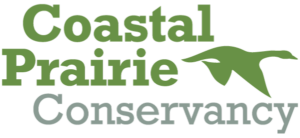
Welcome to the Katy Prairie!
The Coastal Prairie Conservancy (formerly the Katy Prairie Conservancy) was formed in 1992 to conserve the coastal prairie for people and wildlife before it disappears. We are a nationally accredited 501(c)(3) non-profit organization located in Houston, Texas, and a trusted leader in local land protection. We are also one of the largest local land conservation organizations, by acreage, in southeast Texas, protecting over 33,600 acres of coastal prairie. Our primary program areas are conservation, restoration, and outreach.
The Katy Prairie Preserve is our largest contiguous preserve, at over 19,300 acres. It’s made up of lands that the Coastal Prairie Conservancy owns, as well as private lands conserved with a tool known as a conservation easement.
Every acre we protect is a promise kept—to safeguard native plants, enhance water quality, mitigate flooding, and preserve our region’s rich natural heritage for future generations.
Explore the Katy Prairie Preserve by touching the image bubbles on the map to learn more about the Katy Prairie’s unique history, ecology, and points of interest.
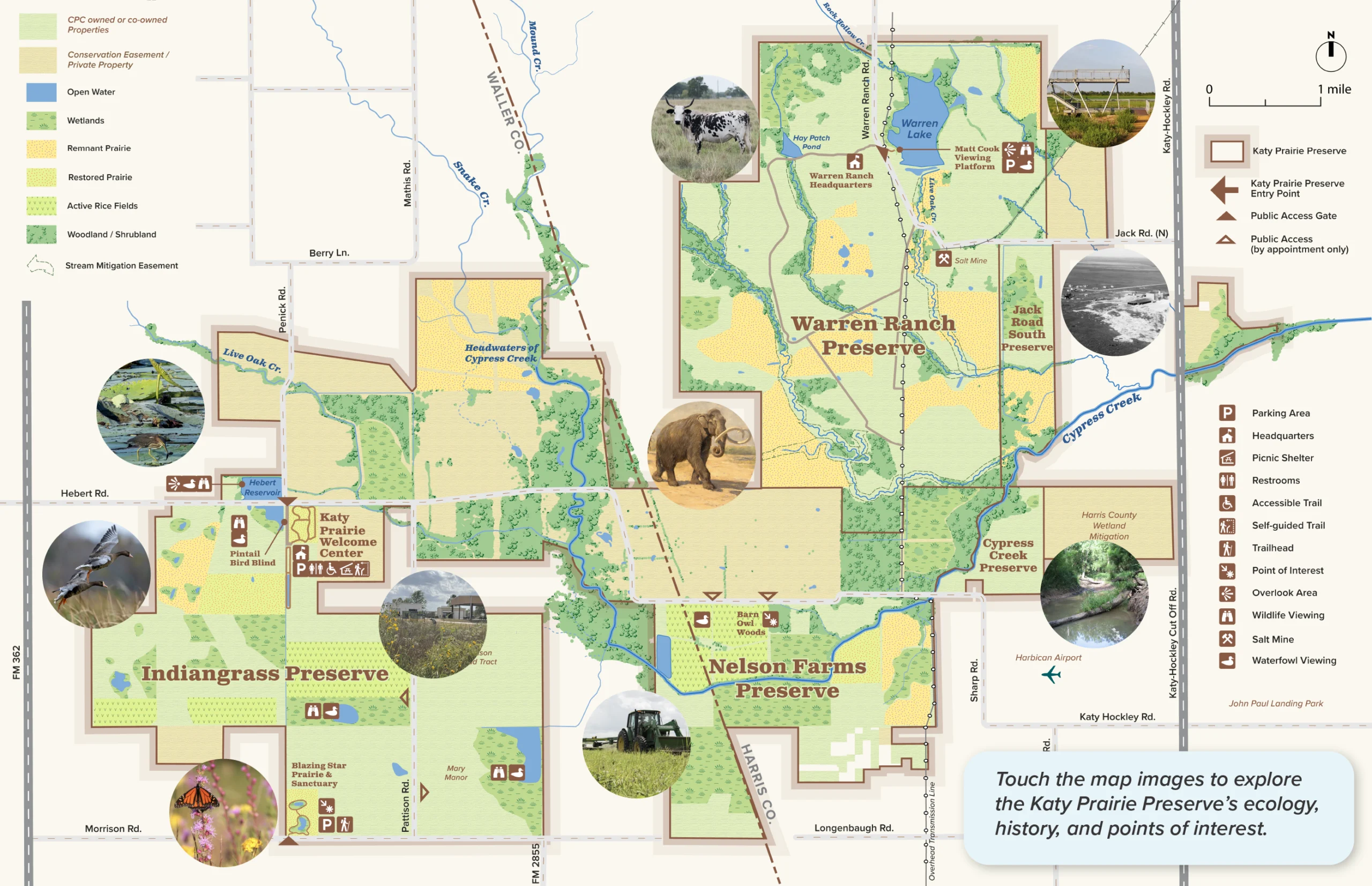
Indiangrass Preserve & Ann Hamilton Trail
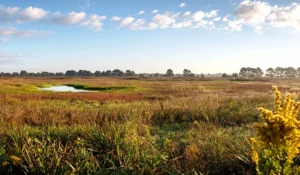
Map Image: Indiangrass Preserve Headquarters by LVBrown Studio; Story image: Indiangrass Preserve Tallgrass prairie and prairie pothole restoration by Don Pine
Indiangrass Preserve is the headquarters of the Katy Prairie Preserve’s educational, field, and volunteer operations and is now home to the Katy Prairie Welcome Center. It’s also the flagship success story of our prairie restoration efforts. Stroll the Ann Hamilton self-guided trail and glimpse back to the Tallgrass prairie landscape before European settlement.
Imagine a waving sea of hundreds of native grasses growing to a horse rider’s knees. Did you know the roots of the preserve’s namesake, Indiangrass, can extend nine feet into the soil and grow as tall as seven feet?!
Wildflowers growing amongst the tall grasses provide sources of food for our many native pollinators like the Monarch Butterfly.
The Katy Prairie was once dimpled with small, shallow wet depressions called “prairie potholes,” forming a constellation of wetland oases for prairie wildlife, such as Eastern Spotted Skunk, Western Chicken Turtle, and Crawfish Frog.
Mark your calendar for seasonal events such as classes, tours, and opportunities to get involved with our prairie restoration efforts.
Warren Lake & Matt Cook Viewing Platform
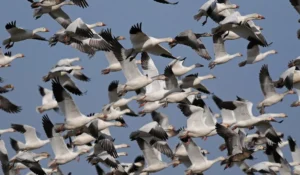
Map Image: Matt Cook Memorial Wildlife Viewing Platform from Shrike Prairie trail by Frank Farese; Story image: Flock of snow geese by Jimmy Kall.
A short walk through Shrike Prairie leads to the Matt Cook Overlook. The ADA-accessible two-story platform overlooking Warren Lake is dedicated to the memory of a young wildlife and fisheries graduate student who loved the outdoors and spent many hours studying and enjoying the wildlife of the Katy Prairie. Warren Lake is a former rice reservoir on the Warren Ranch Preserve and is the largest and deepest body of water on the Katy Prairie Preserve. Rice reservoirs constructed during the heyday of Gulf Coast rice farming once attracted snow geese by the hundreds of thousands in winter. In fact, protecting this migratory bird overwintering wetland habitat was a key reason for the formation of the Katy Prairie Conservancy in 1992 (now Coastal Prairie Conservancy)—and why the snow goose is our logo mascot.
Today, the 160 acres of open water at Warren Lake attracts a wide variety of waterbirds and often raucous flocks of waterfowl year-round. Bring your binoculars to catch a closer look at dabbling ducks such as Blue-winged Teal and Northern Shoveler and larger migratory birds such as Roseate Spoonbill and American White Pelican.
The platform is open 365 days a year, dawn to dusk. Come and enjoy one of the best bird watching locations along the Texas Gulf Coast.
Warren Ranch: Historic Cattle Ranch
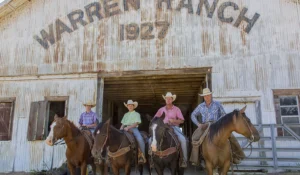
Map Image: Cattle in pasture by Karen Sachar; Story image: Cowboys on horseback in front of historic 1927 Warren Ranch horse barn by Kathy Adams Clark
The Warren Ranch is over 6000 acres of protected lands and is roughly one-third of the Katy Prairie Preserve. The Warren Ranch is the largest remaining and one of the longest operating working ranches in Harris County.
Coastal Prairie Conservancy co-owns this property with the Warren family, multi-generational Texas ranchers and cowboys who’ve continuously operated here since the 1870s. The Warrens arrived in the Gulf Coast plains with other German, Polish, and Czech settlers lured by the promise of open, fertile land with ample water. By 1897, the 200 or so settlers in the little prairie town of Waller, TX made their living off the land as cattle ranchers and cotton and corn farmers.
In 2003, the Warrens chose to work with the Conservancy to preserve the land and their ranching way of life. They are important partners in the Katy Prairie’s restoration, rotationally grazing hundreds of cattle in fenced-off fields to protect pockets of remnant prairie, wetlands, and the headwater tributaries to Cypress Creek.
Nelson Farms Preserve: Rice Farming
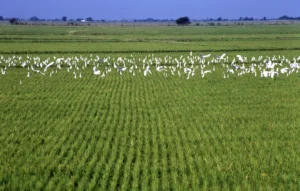
Map Image: Harvesting rice; Story image: Egrets in rice field by Michael Morton.
Nelson Farms Preserve contains the very first protected parcel at the Katy Prairie Preserve (554 acres) and the last working rice farm in Harris County. Rice farming was once widespread across the Gulf Coast plains in the 1950s and 60s, as the flat and poorly drained soils are ideal for growing wetland plants, such as rice. Farmers altered the prairie landscape by digging water storage reservoirs and irrigation canals. They leveled the land to create a system of floodable fields.
The wet fields attracted migrating ducks, geese, and cranes, providing over-wintering food and shelter. As bird numbers grew, so did interest in duck hunting and bird watching. While rice production has waned, the desire to preserve waterfowl habitat and a piece of Gulf Coast history remains. This is why you’ll see portions of the Katy Prairie Preserve still in active rice production today.
The now 1700-acre Nelson Farms Preserve contains rice wetlands, cattle pasture, restored wetlands, remnant prairie, and a small woodlot called “Barn Owl Woods.” Entry to Nelson Farms is for guided tours only by appointment.
Hebert Reservoir Wetland Preserve

Map Image: Green Heron in Hebert Reservoir lotus bed by Paul Stirling; Story image: Hebert Reservoir Lotus in bloom by Bethany Foshee.
One of the smallest parcels in the Katy Prairie Preserve is also its hidden watery gem. The 77-acre former rice reservoir was acquired by CPC in 2000, purchased from the Hebert family whose history in the area extends to the 1860s. The reservoir is covered with water in a wet year and can be entirely blanketed by American Lotus in summer.
Many wetland plants grow here, such as Maidencane, switchgrass, green Flatsedge, jungle rice, and square stem spike rush. Crayfish, frogs, softshell turtles and even American Alligator are found lurking below the water’s surface, while Great Blue Heron and Snowy Egret watch and ‘wade’ from above. Rarer birds, like Least Grebes, can sometimes be spotted here too.
Hebert Reservoir is publicly accessible 365 days a year from dawn to dusk. A short out-and-back trail on the raised levee provides wildlife observation opportunities, including shade and bench seating. Bring your binoculars and find a quiet place to watch the wonderful wetland wildlife at Hebert Reservoir.
Wetlands and Waterfowl of the Katy Prairie
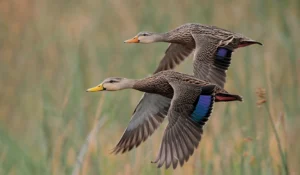
Map Image: White-fronted Geese by Tommy Kibodeaux; Story image: Mottled Ducks coming in for a landing in the Indiangrass Preserve by Greg Lavaty.
The Katy Prairie once contained many small wetlands before decades of farming practices smoothed the prairie’s natural dips and bumps. Wetlands are rich ecosystems and support all Katy Prairie wildlife. They’re also crucial stopover habitat for the migration of millions of birds (and butterflies) along the North American Central Flyway.
Did you know that the Katy Prairie is home to more than 300 species of migratory and resident birds. Resident ducks, like Mottled and Whistling duck, love the wetlands’ open water, and shorebirds like sandpipers, stilts, and avocets, feast in the seasonal mudflats. Keep your eye out for grassland songbirds and prairie raptors too!
Today, the Conservancy is involved in large-scale earthwork projects to restore wetlands. We partner with hunters to conserve waterfowl habitat and organize youth hunting programs. The Katy Prairie is also part of the Texas Parks and Wildlife Waterfowl Sanctuary Program. Visit the new bird blind to catch the main attraction of our many wetland reconstruction projects on the Katy Prairie, BIRDS!
Headwaters of Cypress Creek Watershed
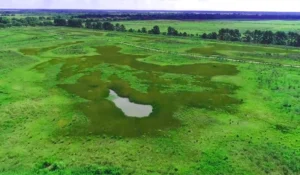
Map Image: Cypress Creek in Nelson Farms Preserve by Jaime Gonzalez; Story image: Indiangrass Preserve wetland drone image by CPC.
The headwaters of Cypress Creek—the mainstem of the fifth largest watershed in Harris County—begins in the Katy Prairie. While mostly hidden from public view, Cypress Creek strings many Katy Prairie Preserve units together.
Keeping the prairie open as a natural area provides flood control benefits to downstream neighbors. The prairie acts like a sponge, holding back potential floodwaters. In addition, prairie plants’ deep roots and dense shoots help capture, filter, and recharge groundwater tied to our regional drinking water supply.
The Conservancy has completed over 15 miles of stream restoration projects across the Warren Ranch. Re-meandering the creek bed, keeping cattle out of the stream corridor, removing invasive species, and restoring native plant communities all contribute to the health of Cypress Creek and the watershed.
The 323-acre Cypress Creek Preserve is not currently open to the public. Contact the Conservancy to learn more about site tours and volunteer events.
Prairie Disturbance: A Long History of Grazing
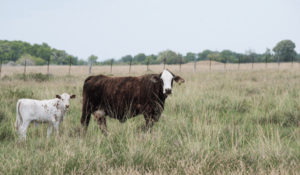
Map Image: Columbian Mammoth illustration courtesy of American Museum of Natural History; Story image: Cows in field by Karen Sachar.
Prairies are disturbance-dependent ecosystems. Disturbances, like fire and grazing, keep invasive plants and woody species at bay, clearing the way for new prairie seeds to germinate and bloom. That’s why CPC staff and volunteers burn the prairie approximately once every three years.
The Gulf Coast prairie was once a vast grassland, sweeping across nine million acres from Corpus Christi, TX, to Lafayette, LA. During the Pleistocene, giant herbivores (plant-eaters) such as mammoths, mastodon, and Bison antiquus grazed the coastal grasslands. Fossilized bones of these ancient grazers were even found here on the Katy Prairie Preserve! Native Americans such as the Akokisa depended on this wild game, and they managed grassland habitat for them.
While bison no longer roam the Katy Prairie, their close bovine cousin does, the domestic cow. Cattle grazing is embedded in Texan culture and is an active approach to prairie maintenance at the Katy Prairie Preserve. It takes about one cow per ten acres to help manage our prairie grassland.
Nature’s Burial at Blazing Star Prairie
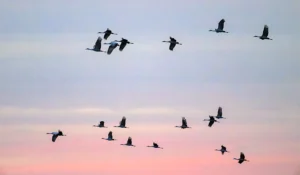
Map Image: Prairie plants and pollinators; Story image: Sandhill Cranes at sunset by Don Pine.
Blazing Star Prairie is our new 68-acre preserve unit located in the southernmost portion of the Indiangrass Prairie Preserve. Nestled within this new preserve is Blazing Star Sanctuary, a 7.5-acre natural burial ground. The sanctuary is also Texas’ first-ever certified conservation cemetery. Restoration of the Blazing Star Prairie began with removing invasive plant species and fencing out cattle. Fourteen acres of new wetland habitat have been added. The prairie restoration project is underway and will be completed in late 2025. The fully realized preserve will include a natural-surface trail system, wetland boardwalks, a shade structure, and pollinator gardens.
Green burials use non-toxic and biodegradable materials. Unlike conventional cemeteries, there are no above-ground headstones. Instead, the natural burial ground is a prairie landscape blanketed by grasses and native wildflowers. Those who choose a burial plot here can create a natural legacy and preserve a piece of Texas forever. Learn more at naturesburial.org.
Soon, this preserve will be open during regular visitor hours. While under restoration, the preserve is open by appointment, for guided tours, and open house events.
Hockley Salt Dome & Texas Prairie Dawn
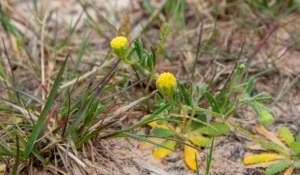
Map Image: Hockley Salt Dome from above, historical aerial image; Story image: Texas Prairie Dawn by Jeff Hodges
The Warren Ranch sits atop the Hockley Salt Dome, a naturally occurring rock salt formation. The dome is approximately 1.3 miles in diameter and formed during the Jurassic period.
Salt mining began here in 1932, and the mine is still active today. Salts extracted by miners from the depths of the dome are used to de-ice roadways, soften our water, and provide salt supplements for livestock, under the brand name “Ranch House Salt.” You can see the mine’s aboveground structures in the Warren Ranch Preserve on the drive to the Matt Cook Overlook.
The shallow salt dome affects the soil chemistry above, making the soil slightly salty or “saline.” Some plants, like the Texas Prairie Dawn, are uniquely adapted to live in saline soils. This small and delicate wildflower is federally and state-endangered and is quite rare. Of the only five Texas counties where the plant is found, Harris County boasts one of Prairie Dawn’s largest populations of plants. Join us in March-April when the tiny yellow flowers bloom to help count and monitor this precious wildflower.